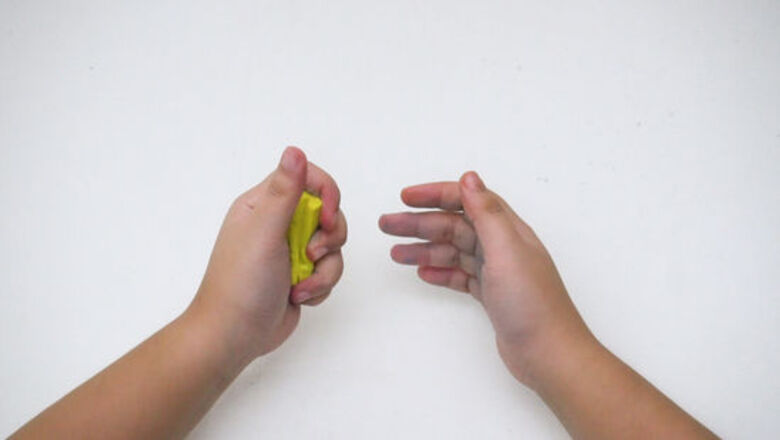
views
Making Basic Daisies
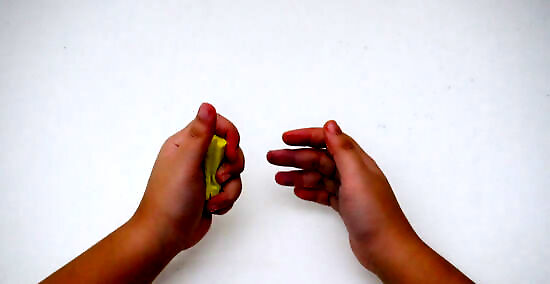
Hold and rub the clay in your hands to warm it up. Roll and knead the clay of your choice in your hands. You can use white clay for the entire flower or a different color for your petals and for the center of the flower. When the clay is ready, it’ll be easy to squeeze and flatten it between your hands.
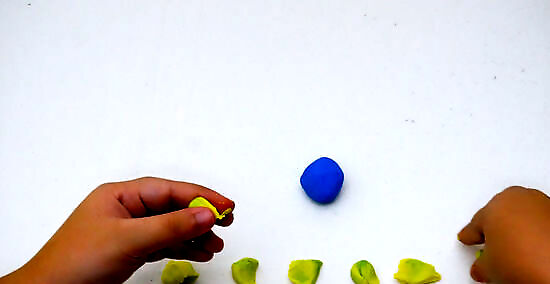
Roll 1 clay ball for each petal of the daisy. Decide how many petals you want to have around your daisy, and break off equal sized pieces of clay from the main ball of clay. Then, use your hands to make balls out of the pieces of clay. Most daisies have anywhere from 5-20 petals. If you want a daisy with a lot of petals, make 16-20 balls. If you want a daisy with space in between the petals, make 5-7 balls. You can roll the pieces between your hands or fingers to make the balls.
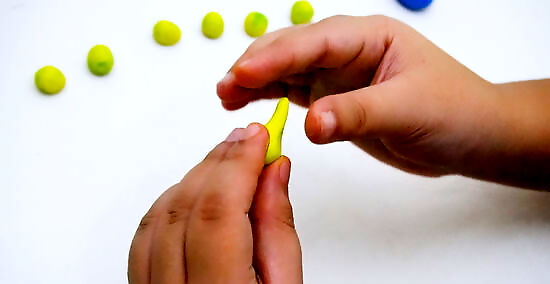
Pinch and roll the top of the clay ball to form a teardrop shape. Once you’ve made all of the balls, use your thumb and forefinger to elongate the top of each ball. Then, roll it into a cone shape to form a tear drop. The pointed end will be behind the center of the daisy, and the thicker end will be the visible part of the petal.
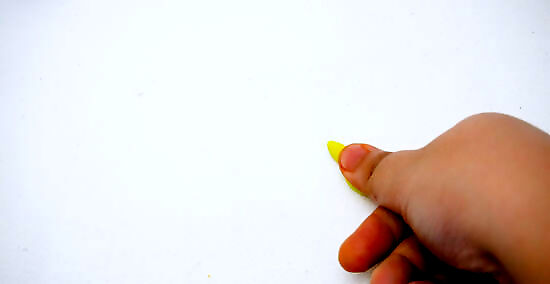
Press down on the larger end of the tear drop to flatten it. Use your thumb or a tool to gently flatten the thicker end. Then, carefully smooth the sides and elongate the petal by pinching and pulling slightly on the flattened part. Once it’s long enough, flatten the pointed end of the petal until it’s the same thickness as the wider end. Make sure all of your petals are roughly the same size and shape. If one of them looks a little too small or large, simply roll it back into a ball and try again.

Make another ball of clay for the center of the daisy. Pull off a piece from the main ball of clay, and roll it between your hands or fingers. Then, place the ball on a flat surface to build the flower around it. The ball should be around the same size as the balls you made for the petals.
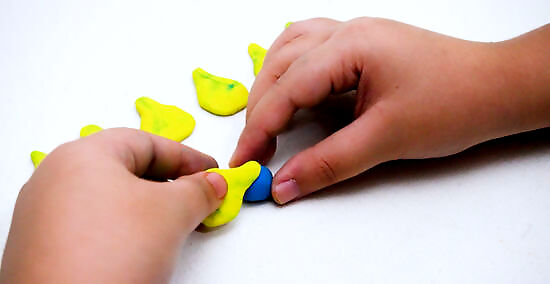
Arrange your petals on top of the ball, radiating outward in a circle. Place the petals upside-down on the ball, with the pointed end on top of the ball. Overlap them slightly if you have a lot of petals, or just barely let them touch if you only have a few. Try to keep the arrangement even with the petals equally distributed around the center. If you have more petals on one side, the flower will look lopsided.
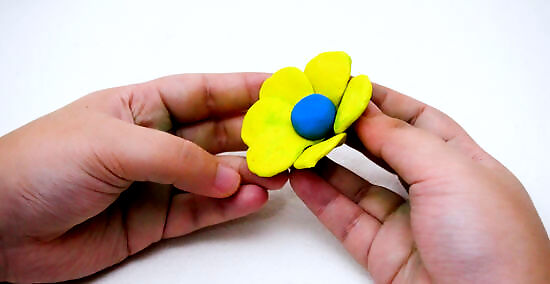
Turn the flower over and press down on the center to flatten it slightly. Carefully lift the flower up and place it with the petals on the back. If you’re going to bake the clay, place it on a tray or ceramic baking dish. Then, use your thumb to gently press on the center ball of the daisy to make sure it sticks to the petals. Don’t press too hard on the center because this can cause an indentation. Make sure the circle is still slightly raised.
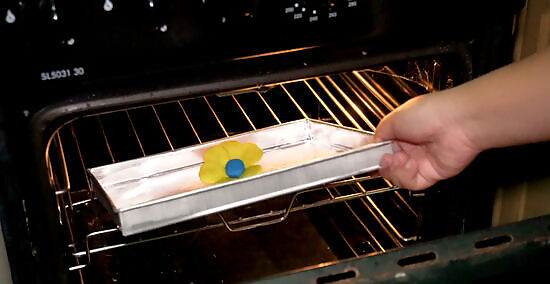
Bake the flower for 15 minutes at 265 °F (129 °C) to harden it. If you want your clay flower to last for a long time, you can bake it in the oven. Preheat the oven to the right temperature while you work on the flower, and put it in the oven when you’ve finished it. Remember to check the packaging for the clay to make sure you can safely put it in the oven. If you want to wear your flower, you can make it into a necklace or poke holes into a smaller daisy to make a button for a jacket.
Creating Clay Roses
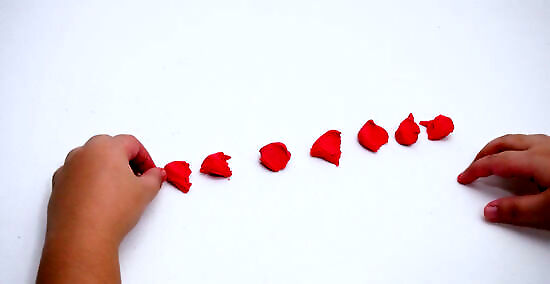
Divide a ball of clay into 7 roughly equal pieces. If you want to make a larger rose, start with a larger piece of clay. For a smaller rose, start with a smaller amount of clay. The pieces don’t have to be the same size, but should generally be about even. You don’t need to roll the pieces into a ball since they don’t need to be perfect shapes for making the rose.

Flatten one of the pieces into a rounded triangle with a thinner point. Try to find the smallest piece of clay. Then, press it until it’s in a triangular shape with rounded edges, like a guitar pick. Press on the top part of the triangle to make it slightly thinner than the bottom of the triangle. The thin part will be folded into the “bud” of the rose, and the rest of the petals will wrap around this part. Making the bud thin will prevent the rose from becoming too bulky.
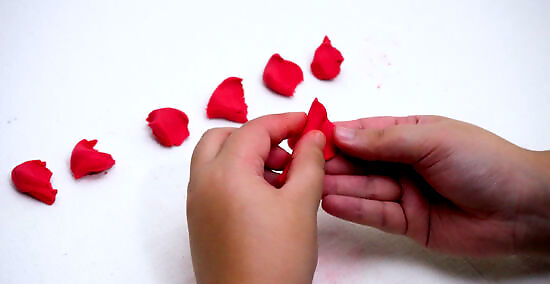
Hold the triangle with the pointed side down, folding 1 side over the other. Pinch the bottom of the triangle between your thumb and forefinger, with one side under the other side. Then, roll them between your fingers slightly to form a cone-like shape at the bottom of the rose. The top of the petal might curl slightly as you roll the bottom part. You can leave it slightly curled or flatten it if you prefer the rose to look like it hasn’t yet bloomed.

Flatten the rest of the pieces into rounded triangles. Repeat the process of making rounded triangles for the other 6 petals. Remember to keep the bottoms of the petals slightly thinner than the tops to prevent the rose from becoming too bulky. If you can, try to organize them by size from smallest to largest pieces. You’ll use the smallest pieces first and the use the 3 largest pieces to form the outer petals.
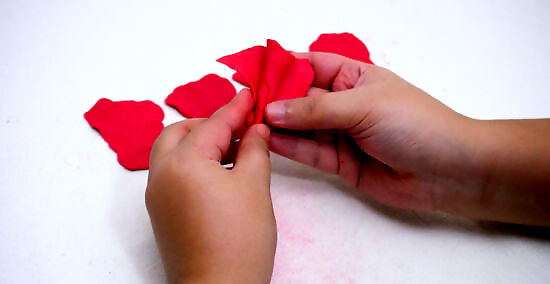
Wrap the bottom of the next petal around the bud on the opposite side. Take the next largest petal and hold it so that the top of the petal is opposite the top of the folded bud. Then, wrap the bottom of the petal around the bottom of the bud to connect them. If you want the rose to look like it is blooming, you can curl the top of the petal back slightly to make the top of the rose look more open.
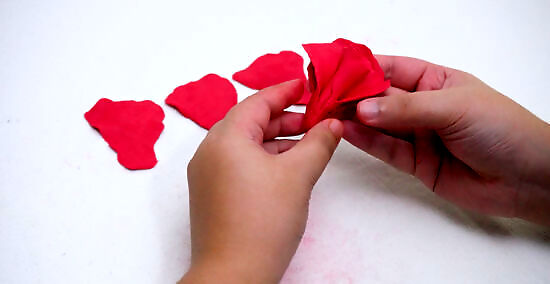
Attach the next 2 petals staggered between the first 2 petals. Place one petal where the bud and the 2nd petal overlap, and wrap the bottom of the petal around the bud area. Then, place the other petal on the opposite side where the petals overlap, wrapping it around the bud area on the bottom of the rose. At this point, you should have 4 petals on your rose, and you should be able to see 3-4 places where the petals overlap. Keep curling the tops of the petals back if you want the rose to look like it’s blooming.
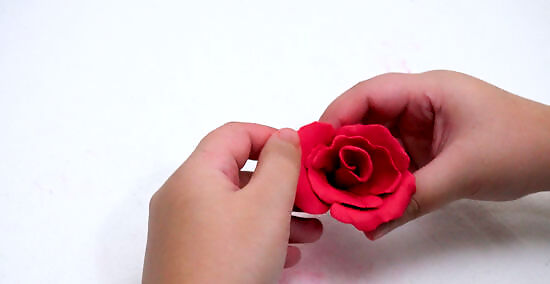
Place the final 3 petals on the spots where the other petals overlap. Take the next petal and put it on a place where the petals overlap, wrapping the bottom around the buds. Then, rotate the rose slightly and add another petal to a different place where the petals overlap. Finally, add the last petal at a different place where the petals touch, and wrap the bottom around the bud, smoothing it with your hand. Curl the outer petals outward to make the rose look like it’s in bloom. Shape the outer petals to bend inward slightly if you want the rose to look like it hasn’t bloomed yet.

Bake the rose at 265 °F (129 °C) for 15 minutes if you want to harden the clay. If you want the rose to last for a long time, preheat the oven before you start making your flower. Place the rose on a tray or baking dish with the bud on the bottom so the top doesn’t become flattened. Be sure to check the package for the clay before baking it in the oven. Some clays require a higher temperature for baking. If you don’t want to harden your clay, you don’t have to bake it.




















Comments
0 comment